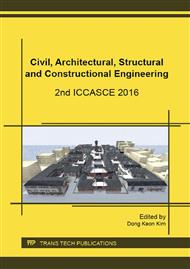[1]
N. T. Basta, S. L. McGowen, Evaluation of chemical immobilization treatments for reducing heavy metal transport in a smelter-contaminated soil, Environ. Pollut. 127(1) (2004) 73-82.
DOI: 10.1016/s0269-7491(03)00250-1
Google Scholar
[2]
B. Wang, Z. Xie, J. Chen, et al. Effects of field application of phosphate fertilizers on the availability and uptake of lead, zinc and cadmium by cabbage (Brassica chinensis L. ) in a mining tailing contaminated soil, J. Environ. Sci. 20(9) (2008).
DOI: 10.1016/s1001-0742(08)62157-9
Google Scholar
[3]
G. M. Hettiarachchi, G. M. P. And, M. D. Ransom, In Situ Stabilization of Soil Lead Using Phosphorus and Manganese Oxide, Environ. Sci. Technol. 34(21) (2000) 4614-4619.
DOI: 10.1021/es001228p
Google Scholar
[4]
G. Machender, R. Dhakate, L. Prasanna, et al. Assessment of heavy metal contamination in soils around Balanagar industrial area, Hyderabad, India, Environ. Earth Sci. 63(5) (2011) 945-953.
DOI: 10.1007/s12665-010-0763-4
Google Scholar
[5]
J. M. Soriano-Disla, T. W. Speir, I. Gómez, et al. Evaluation of Different Extraction Methods for the Assessment of Heavy Metal Bioavailability in Various Soils, Water Air Soil Pollut. 213(1-4) (2010) 471-483.
DOI: 10.1007/s11270-010-0400-6
Google Scholar
[6]
S. Das, S. C. Patnaik, H. K. Sahu, et al. Heavy metal contamination, physico-chemical and microbial evaluation of water samples collected from chromite mine environment of Sukinda, India, Trans. Nonferrous Metals Soc. China, 23(2) (2013) 484-493.
DOI: 10.1016/s1003-6326(13)62489-9
Google Scholar
[7]
X. H. Li, The mine environmental pollution and remediation in large metal mines, Lanzhou: Lanzhou University, (2007).
Google Scholar
[8]
F. R. Burden, D. Donnert, T. Godish, I. D. Mckelvie, Environmental monitoring handbook, Boston: The McGraw-Hill Companies, (2004).
Google Scholar
[9]
W. Guo, R. X. Zhao, J. Zhang, et al. Distribution characteristic and assessment of soil heavy metal pollution in the iron mining of Baotou in Inner Mongolia, Chin. J. Environ. Sci. 32(10) (2011) 3099-3105.
Google Scholar
[10]
R. Herwijnen, T. R. Hutchings, A. Al-Tabbaa, et al. Remediation of metal contaminated soil with mineral-amended composts, Environ. Pollut. 150(3) (2007) 347-354.
DOI: 10.1016/j.envpol.2007.01.023
Google Scholar
[11]
R. Terzano, M. Spagnuolo, L. Medici, et al. Zeolite synthesis from pre-treated coal fly ash in presence of soil as a tool for soil remediation, Appl. Clay Sci. 29(2) (2005) 99-110.
DOI: 10.1016/j.clay.2004.12.006
Google Scholar
[12]
Y. J. Du, M. L. Wei, K. R. Reddy, et al. New phosphate-based binder for stabilization of soils contaminated with heavy metals: Leaching, strength and microstructure characterization, J. Environ. Manag. 146 (2014) 179-188.
DOI: 10.1016/j.jenvman.2014.07.035
Google Scholar
[13]
Y. Y. Yang, H. L. Wu, Y. J. Du, Strength and Leaching Characteristics of Heavy Metal Contaminated Soils Solidified by Cement, J. Residuals Sci. Technol., 11(3) (2014) 71-98.
Google Scholar
[14]
S. Paria, P. K. Yuet, Solidification–stabilization of organic and inorganic contaminants using portland cement: a literature review, Environ. Rev. 14(4) (2006) 217-255 (39).
DOI: 10.1139/a06-004
Google Scholar
[15]
D. Dermatas, X. Meng, Utilization of fly ash for stabilization/solidification of heavy metal contaminated soils, Eng. Geol. 70(3-4) (2003) 377-394.
DOI: 10.1016/s0013-7952(03)00105-4
Google Scholar
[16]
Y. Liang, X. C. Wang, X. D. Cao, et al. Immobilization of Pb, Cu, and Zn in a Multi-Metal Contaminated Soil Amended with Triple Superphosphate Fertilizer and Phosphate Rock Tailing, Adv. Mater. Res. 356-360 (2011) 1716-1718.
DOI: 10.4028/www.scientific.net/amr.356-360.1716
Google Scholar
[17]
Y. J. Du, N. J. Jiang, S. Y. Liu, F. Jin, D. N. Singh, A. Pulppara, Engineering properties and microstructural characteristics of cement solidified zinc-contaminated kaolin clay, Can. Geotech. J. 1(3) (2014) 289-302.
DOI: 10.1139/cgj-2013-0177
Google Scholar
[18]
C. K. Chau, F. Qiao, Z. J. Li, Microstructure of magnesium potassium phosphate cements, Constr. Build. Mater. 25(6) (2011) 2911-2917.
Google Scholar
[19]
S. Mignardi, A. Corami, V. Ferrini, Evaluation of the effectiveness of phosphate treatment for the remediation of mine iste soils contaminated with Cd, Cu, Pb, and Zn, Chemosphere, 86(4) (2012) 354-360.
DOI: 10.1016/j.chemosphere.2011.09.050
Google Scholar
[20]
A. Navarro, E. Cardellach, M. Corbella, Immobilization of Cu, Pb and Zn in mine-contaminated soils using reactive materials, J. Hazard. Mater. 186(2) (2011) 1576-1585.
DOI: 10.1016/j.jhazmat.2010.12.039
Google Scholar
[21]
P. Desogus, P. P. Manca, G. Orrù, et al. Stabilization–solidification treatment of mine tailings using Portland cement, potassium dihydrogen phosphate and ferric chloride hexahydrate, Minerals Eng. 45 (2013) 47-54.
DOI: 10.1016/j.mineng.2013.01.003
Google Scholar


